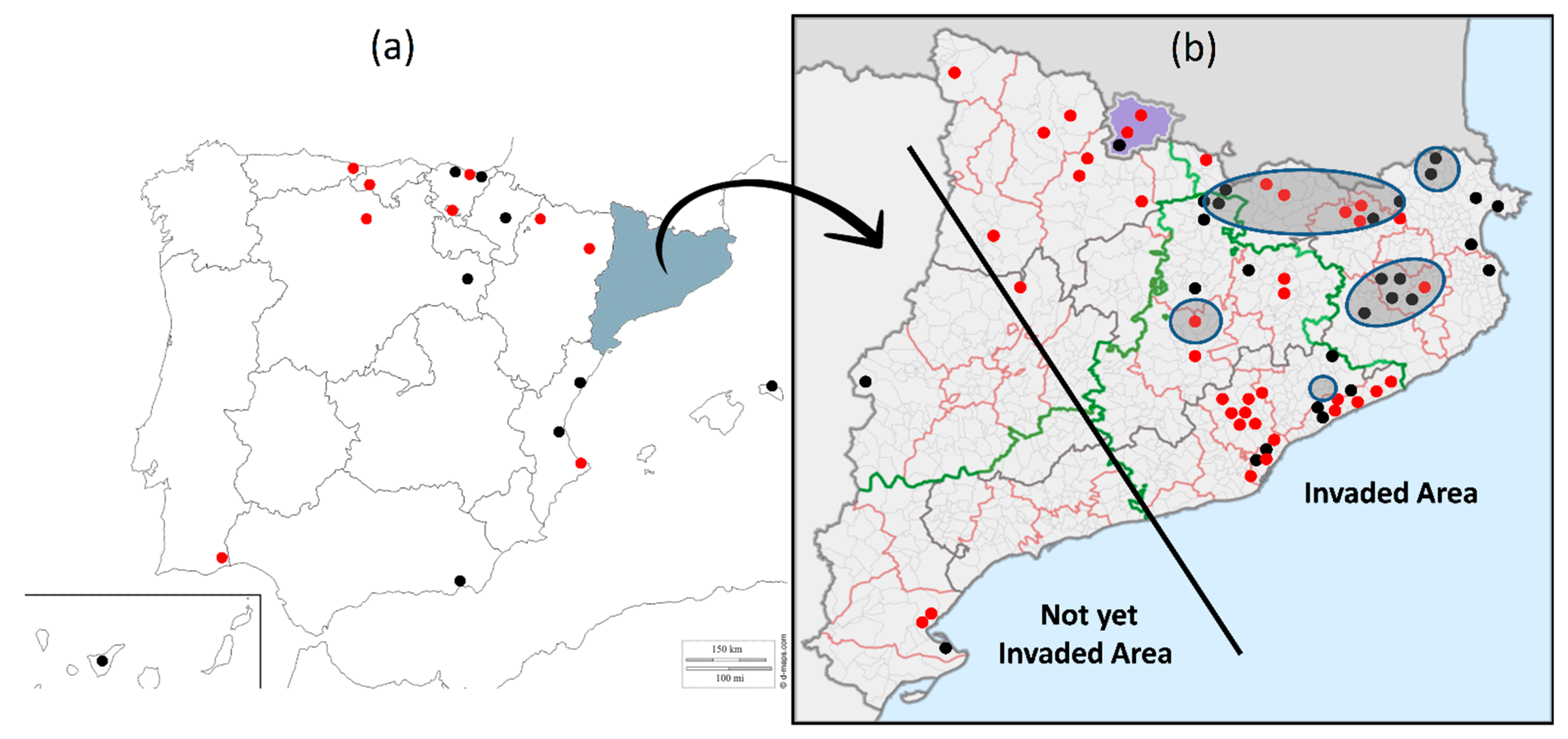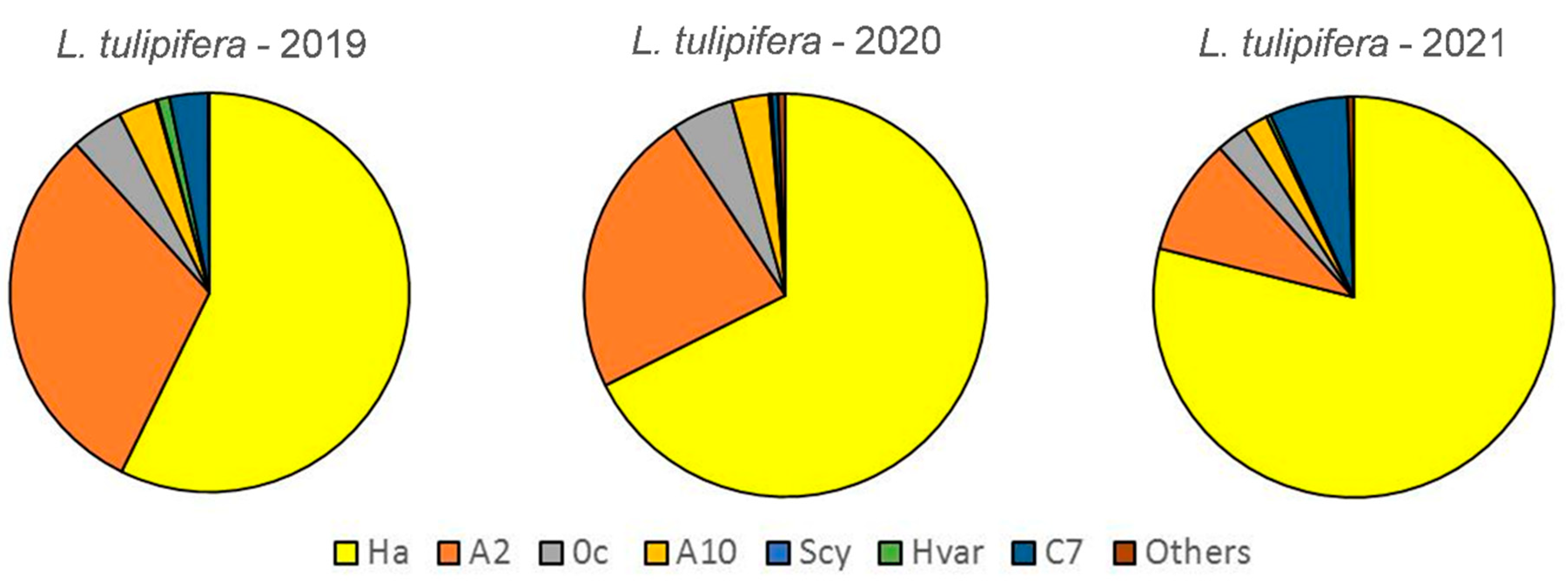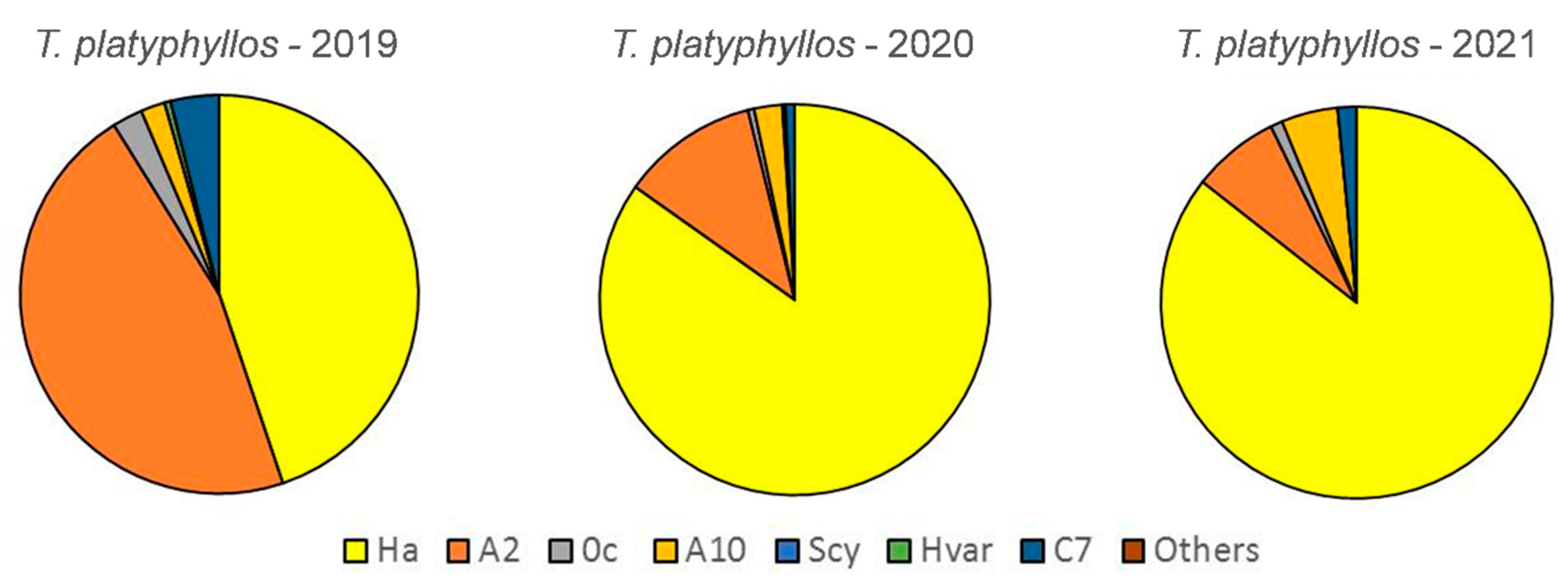Establishment and Expansion of Harmonia axyridis Pallas (Coleoptera: Coccinellidae) in Urban Green Areas in the Iberian Peninsula: From 2015 to 2021
Abstract
Simple Summary
Abstract
1. Introduction
2. Material and Methods
Statistical Analysis
3. Results
3.1. Occurrence of H. axyridis
3.2. Abundance of Ladybirds in the Not Yet Invaded and Invaded Areas
| (a) | ||||||||||
| Ladybird Species | ||||||||||
| Year | Sample Sites | A2 | Oc | A10 | C7 | Hvar | P14 | Scy | Differences between Years | |
| 2015 | 9 | 0 (0) | 48 (26) | 13 (7) | 4 (2) | 21 (11) | 4 (2) | 9 (5) | bc | |
| 2016 | 13 | 0 (0) | 48 (40) | 17 (14) | 3 (2) | 22 (18) | 1 (1) | 8 (7) | c | |
| 2017 | 16 | 4 (5) | 40 (48) | 12 (14) | 2 (3) | 28 (34) | 5 (6) | 9 (11) | bc | |
| 2018 | 16 | 11 (12) | 37 (41) | 12 (14) | 2 (2) | 27 (30) | 3 (4) | 6 (7) | bc | |
| 2019 | 13 | 15 (40) | 36 (97) | 8 (23) | 1 (2) | 34 (93) | 2 (7) | 4 (10) | b | |
| 2020 | 13 | 38 (117) | 30 (93) | 12 (36) | <1 (1) | 14 (42) | 1 (4) | 5 (15) | a | |
| 2021 | 7 | 41 (33) | 18 (14) | 10 (8) | 4 (3) | 20 (16) | 4 (3) | 4 (3) | a | |
| (b) | ||||||||||
| Ladybird Species | ||||||||||
| Year | Sample Sites | Ha | A2 | Oc | A10 | C7 | Hvar | P14 | Scy | Differences between Years |
| 2015 | 13 | 0 (0) | 56 (178) | 8 (25) | 3 (10) | 3 (8) | 26 (84) | 2 (7) | 1 (4) | f |
| 2016 | 9 | 0 (0) | 53 (39) | 5 (4) | 9 (7) | 6 (5) | 29 (15) | 1 (1) | 3 (2) | ef |
| 2017 | 10 | 6 (12) | 46 (98) | 8 (18) | 12 (26) | 5 (11) | 15 (31) | 4 (8) | 5 (10) | de |
| 2018 | 16 | 17 (29) | 34 (57) | 12 (20) | 12 (20) | 4 (7) | 13 (23) | 4 (6) | 5 (9) | d |
| 2019 | 19 | 52 (371) | 24 (172) | 6 (39) | 3 (22) | 2 (13) | 13 (95) | <1 (1) | <1 (2) | c |
| 2020 | 42 | 43 (559) | 34 (442) | 7 (85) | 4 (56) | 1 (11) | 10 (128) | <1 (4) | 1 (8) | b |
| 2021 | 16 | 63 (279) | 25 (109) | 4 (17) | 3 (13) | 4 (18) | <1 (2) * | <1 (2) | <1 (2) | a |
3.3. Changes in the Relative Abundance of the Aphidophagous Ladybird Species on L. tulipifera and T. platyphyllos
4. Discussion
5. Conclusions
Supplementary Materials
Author Contributions
Funding
Institutional Review Board Statement
Data Availability Statement
Acknowledgments
Conflicts of Interest
References
- Blackman, R.L.; Eastop, V.F. Taxonomic issues. In Aphids as Crop Pest; van Emden, H.F., Harrington, R., Eds.; CAB International: Willingford, UK, 2007; pp. 1–29. [Google Scholar]
- Dixon, A.F.G. Parthenogenetic reproduction and the rate of increase in aphids. In Aphids, Their Biology, Natural Enemies and Control; Minks, A.K., Harrewijn, P., Eds.; Elsevier: Amsterdam, The Netherlands, 1987; Volume A, pp. 269–287. [Google Scholar]
- Völkl, W.; Mackauer, M.; Pell, J.K.; Brodeur, J. Predators, parasitoids and pathogens. In Aphids as Crop Pests; van Emden, H.F., Harrington, R., Eds.; CAB International: Willingford, UK, 2007; pp. 187–233. [Google Scholar]
- Majerus, M.E.N. Ladybirds (New Naturalist 81), 1st ed.; Harper-Collins: London, UK, 1994; p. 367. [Google Scholar]
- Michaud, J.P. Coccinellids in biological control. In Ecology and Behavior of the Ladybird Beetles (Coccinellidae); Hodek, I., Honek, A., van Emden, H.F., Eds.; Blackwell Publishing Ltd.: Chichester, UK, 2012; pp. 488–519. [Google Scholar]
- Roy, H.; Migeon, A. Ladybeetles (Coccinellidae). In BioRisk: Alien Terrestrial Arthropods in Europe; Chapter 8.4; Roques, A., Kenis, M., Lees, D., Lopez-Vaamonde, C., Rabitsch, W., Rasplus, J.Y., Roy, D.B., Eds.; Pensoft: Sofia, Bulgaria, 2010; pp. 293–313. [Google Scholar] [CrossRef]
- Evans, E.W.; Soares, A.O.; Yasuda, H. Invasions by ladybugs, ladybirds, and other predatory beetles. BioControl 2011, 56, 597–611. [Google Scholar] [CrossRef]
- Sloggett, J.J. Aphidophagous ladybirds (Coleoptera: Coccinellidae) and climate change: A review. Insect Conserv. Divers. 2021, 14, 709–722. [Google Scholar] [CrossRef]
- Soares, A.O.; Honek, A.; Martinkova, Z.; Brown, P.M.J.; Borges, I. Can native geographical range, dispersal ability and development rates predict the successful establishment of alien ladybird (Coleoptera: Coccinellidae) species in Europe? Front. Ecol. Evol. 2018, 6, 57. [Google Scholar] [CrossRef]
- Koch, R.L. The multicolored Asian lady beetle, Harmonia axyridis: A review of its biology, uses in biological control, and non-target impacts. J. Insect. Sci. 2003, 3, 32. [Google Scholar] [CrossRef] [PubMed]
- Adriaens, T.; San Martin y Gomez, G.; Maes, D. Invasion history, habitat preferences and phenology of the invasive ladybird Harmonia axyridis in Belgium. BioControl 2008, 53, 69–88. [Google Scholar] [CrossRef]
- Roy, H.; Wajnberg, E. From biological control to invasion: The ladybird Harmonia axyridis as a model species. BioControl 2008, 53, 1–4. [Google Scholar] [CrossRef]
- Brown, P.M.J.; Thomas, C.E.; Lombaert, E.; Jeffries, D.L.; Estoup, A.; Lawson Handley, L.J. The global spread of Harmonia axyridis (Coleoptera: Coccinellidae): Distribution, dispersal and routes of invasion. BioControl 2011, 56, 623–641. [Google Scholar] [CrossRef]
- Roy, H.E.; Adriaens, T.; Isaac, N.J.B.; Kenis, M.; Onkelinx, T.; San Martin, G.; Brown, P.M.J.; Hautier, L.; Poland, R.; Roy, D.B.; et al. Invasive alien predator causes rapid declines of native European ladybirds. Divers. Distrib. 2012, 18, 717–725. [Google Scholar] [CrossRef]
- Rondoni, G.; Athey, K.J.; Harwood, J.D.; Conti, E.; Ricci, C.; Obricky, J.J. Development and application of molecular gut-content analysis to detect aphid and coccinellids predation by Harmonia axyridis (Coleoptera: Coccinellidae) in Italy. Insect Sci. 2015, 22, 719–730. [Google Scholar] [CrossRef]
- Grez, A.A.; Zaviezo, T.; Roy, H.E.; Brown, P.M.J.; Bizama, G. Rapid spread of Harmonia axyridis in Chile and its effects on local coccinellids biodiversity. Divers. Distrib. 2016, 22, 982–994. [Google Scholar] [CrossRef]
- Kenis, M.; Adriaens, T.; Brown, P.M.J.; Katsanis, A.; San Martin, G.; Branquart, E.; Maes, D.; Eschen, R.; Zindel, R.; Van Vlaenderen, J.; et al. Assessing the ecological risk posed by recently establishes invasive alien predator: Harmonia axyridis as a case study. BioControl 2017, 62, 341–354. [Google Scholar] [CrossRef]
- Jacas, J.A.; Urbaneja, A.; Viñuela, E. History and future of introduction of exotic arthropod biological control agents in Spain: A dilemma? BioControl 2006, 51, 1–30. [Google Scholar] [CrossRef]
- Machado, A. El sarantontón asiático Harmonia axyridis (Pallas) presente en Canarias (Coleoptera: Coccinellidae). Vieraea 2006, 34, 71–72. [Google Scholar] [CrossRef]
- Goldazarena, A.; Calvo, D. First record of Harmonia axyridis (Coleoptera: Coccinellidae) from the Iberian Peninsula. Bol. Soc. Entomol Aragonesa 2007, 41, 437–439. [Google Scholar]
- Brown, P.M.J.; Adriaens, T.; Bathon, H.; Cuppen, J.; Goldazarena, A.; Hagg, T.; Kenis, M.; Klausnitzer, B.E.M.; Kovar, I.; Loomans, A.J.M.; et al. Harmonia axyridis in Europe: Spread and distribution of a non-native coccinellid. BioControl 2008, 53, 55–67. [Google Scholar] [CrossRef]
- Carbonell, R.; Sesma, J.M. Confirmada la presencia de Harmonia axyridis (Pallas, 1773) en la Península Ibérica. Primeras citas para Cataluña e Islas Baleares (Coleoptera: Coccinellidae). BV News 2013, 16, 12–17. [Google Scholar]
- Pons, X.; Roca, M.; Lumbierres, B.; Lucas, É. Characterization of a newly established aggregation of the invasive ladybeetle Harmonia axyridis and current status of the invader in Spain. Span. J. Agric. Res. 2015, 13, e1006. [Google Scholar] [CrossRef]
- Sesma, J.M.; Gil-Tapeado, D. La expansión de Harmonia axyridis (Pallas, 1973) en la Peninsula Ibérica (Coleoptera: Coccinellidae). BV News 2020, 9, 1–7. [Google Scholar]
- Purse, B.V.; Comont, R.; Butler, A.; Brown, P.M.J.; Kesel, C.; Roy, H.E. Landscape and climate determine patterns of spread for all colour morphs of the alien ladybird Harmonia axyridis. J. Biogeogr. 2015, 42, 575–588. [Google Scholar] [CrossRef]
- Soares, A.O.; Borges, I.; Borges, P.A.V.; Labrie, G.; Lucas, E. Harmonia axyridis: What will stop the invader? BioControl 2008, 53, 127–145. [Google Scholar] [CrossRef]
- Osawa, N. Population field studies on the aphidophagous ladybird beetle Harmonia axyridis (Coleoptera: Coccinellidae): Resource tracking and population characteristics. Popul. Ecol. 2000, 42, 115–127. [Google Scholar] [CrossRef]
- Roy, H.E.; Brown, P.M.J.; Adriaens, T.; Berkvens, N.; Borges, I.; Clusella-Trullas, S.; Comont, R.F.; De Clercq, P.; Eschen, R.; Estoup, A.; et al. The harlequin ladybird, Harmonia axyridis: Global perspectives on invasion history and ecology. Biol. Invasions 2016, 18, 997–1044. [Google Scholar] [CrossRef]
- Honek, A.; Martinkova, Z.; Strobach, J. Effect of aphid abundance and urbanization on the abundance of Harmonia axyridis (Coleoptera: Coccinellidae). Eur. J. Entomol. 2018, 115, 703–707. [Google Scholar] [CrossRef]
- Sloggett, J.J. Harmonia axyridis (Coleoptera: Coccinellidae): Smelling the rat in native ladybird declines. Eur. J. Entomol. 2017, 114, 455–461. [Google Scholar] [CrossRef][Green Version]
- Soares, A.O.; Honek, A.; Martinkova, Z.; Skuhrovec, J.; Cardoso, P.; Borges, I. Harmonia axyridis failed to establish in the Azores: The role of species richness, intraguild interactions and resource availability. BioControl 2017, 62, 423–434. [Google Scholar] [CrossRef]
- Honek, A.; Dixon, A.F.G.; Soares, A.O.; Skuhrovec, J.; Martinkova, Z. Spatial and temporal changes in the abundance and compostion of ladybird (Coleoptera: Coccinellidae) communities. Insect Sci. 2017, 20, 61–67. [Google Scholar] [CrossRef]
- Poutsma, J.; Loomans, A.J.M.; Aukema, B.; Heijerman, T. Predicting the potential geographical distribution of the harlequin ladybird, Harmonia axyridis, using the CLIMEX model. BioControl 2008, 53, 103–125. [Google Scholar] [CrossRef]
- Amexia, O.M.C.C.; Sipos, J.; Burda, M.; Soares, A.M.V.M.; Soares, A.O. Factors influencing the introduction and spread of Harmonia axyridis in the Iberian Peninsula. Biol. Invasions 2019, 21, 323–331. [Google Scholar] [CrossRef]
- Kulijer, D. First record of invasive species Harmonia axyridis (Pallas, 1773) (Coleoptera: Coccinellidae) in Bosnia and Herzegovina. Acta Entomol. Serbica 2010, 15, 141–143. [Google Scholar]
- Stankovic, V.M.; Koren, T.; Stankovic, I. The harlequin ladybird continues to invade southeastern Europe. Biol. Invasions 2011, 13, 1711–1716. [Google Scholar] [CrossRef]
- Vandereycken, A.; Brostaux, Y.; Joie, E.; Haubruge, E.; Verheggen, F.J. Occurrence of Harmonia axyridis (Coleoptera: Coccinellidae) in field crops. Eur. J. Entomol. 2013, 110, 285–292. [Google Scholar] [CrossRef]
- Pickering, G.J.; Botezatu, A. A Review of Ladybug Taint in Wine: Origins, Prevention, and Remediation. Molecules 2021, 26, 4341. [Google Scholar] [CrossRef] [PubMed]
- Knapp, M.; Nedved, O. Gender and timing during ontogeny matter: Effects of a temporary high temperature on survival, body size and colouration in Harmonia axyridis. PLoS ONE 2013, 8, e74984. [Google Scholar] [CrossRef]
- Benelli, M.; Simon, R.; Francati, S.; Marchetti, E.; Dindo, M.L. Effect of two temperatures on biological traits and susceptibility to a pyrethroid insecticide in an exotic and native coccinellid species. Bull. Insectol. 2015, 68, 23–29. [Google Scholar]
- Biranvand, A.; Nedved, O.; Tomaszewska, W.; Al Ansi, A.N.; Fekrat, L.; Haghghadam, Z.M.; Khormizi, M.Z.; Noorinahad, S.; Senal, D.; Shakarami, J.; et al. The genus Harmonia (Coleoptera, Coccinellidae) in the Middle East region. Acta Entomol. Musei Natl. Pragae. 2019, 59, 163–170. [Google Scholar] [CrossRef]
- Majerus, M.; Strawson, V.; Roy, H. The potential impacts of the arrival of the harlequin ladybird, Harmonia axyridis Pallas (Coleoptera: Coccinellidae), in Britain. Ecol. Entomol. 2006, 31, 207–213. [Google Scholar] [CrossRef]
- Michaud, J.P. Invasion of the Florida citrus ecosystem by Harmonia axyridis (Coleoptera: Coccinellidae) and asymmetric competition with a native species. Cycloneda sanguinea. Environ. Entomol. 2002, 31, 827–835. [Google Scholar] [CrossRef]
- Lucas, E.; Labrie, G.; Vincent, C.; Kovach, J. The multicoloured Asian ladybeetle: Beneficial or nuisance organism? In Biological Control: A Global Perspective; Vincent, C., Goettel, M., Lazarovits, G., Eds.; CAB International: Willingford, UK, 2007; pp. 38–52. [Google Scholar] [CrossRef]
- Lucas, E.; Vincent, C.; Labrie, G.; Chouinard, G.; Fournier, F.; Pelletier, F.; Bostanian, N.; Coderre, D.; Mignault, M.P.; Lafontaine, P. The multicolored Asian ladybeetle Harmonia axyridis in Quebec agroecosystems ten years after its arrival. Euro. J. Entomol. 2007, 104, 737–743. [Google Scholar] [CrossRef]
- Bélanger, E.; Lucas, E. Dominance of the multi-coloured Asian lady beetle Harmonia axyridis in an undisturbed wild meadow ecosystem. Eur. J. Environ. Sci. 2011, 1, 7–14. [Google Scholar] [CrossRef]
- Bahlai, C.A.; Colunga-Garcia, M.; Gage, S.H.; Lamdis, D.A. The role of exotic ladybeetles in the decline of native ladybeetle populations: Evidence from long-term monitoring. Biol. Invasions 2015, 17, 1005–1024. [Google Scholar] [CrossRef]
- Gardiner, M.M.; Prajzner, S.P.; Burkman, C.E.; Alkbro, S.; Grewal, P.S. Vacant land conversion to community gardens: Influences on generalist arthropod predators and biocontrol services in urban greensapaces. Urban Ecosyst. 2014, 17, 101–122. [Google Scholar] [CrossRef]
- Grez, A.A.; Zaviezo, T.; Gardiner, M.M.; Alaniz, A.J. Urbanization filters coccinellids composition and functional trait distributions in greenspaces across greater Santiago, Chile. Urban For. Urban Green. 2019, 38, 337–345. [Google Scholar] [CrossRef]
- Lumbierres, B.; Pons, X.; Starý, P. Parasitoids and predators of aphids associated with public green areas of Lleida (NE Iberian Peninsula). Adv. Hortic. Sci. 2005, 19, 69–75. [Google Scholar]
- Pons, X.; Lumbierres, B. Control integrado de plagas en espacios verdes urbanos. In Hacia la Gestión Integrada de Plagas, Proceedings of the 12th Symposium Sanidad Vegetal, Sevilla, Spain, 23–25 January 2013; Consejería de Agricultura, Pesca y Medio Ambiente, Ed.; Servicio de Publicaciones y Divulgación—Consejería de Agricultura, Pesca y Medio Ambiente: Sevilla, Spain, 2013; pp. 145–184. [Google Scholar]
- Ottart, N. Impacts de la Coccinelle Invasive Harmonia axyridis sur les Populations de Coccinelles Indigenes a Bruxelles; TFE, Université Libre de Bruxelles, Ecole Interfacultaire de BioIngénieur: Brussels, Belgium, 2005. [Google Scholar]
- Durieux, D.; Fischer, C.; Brostaux, Y.; Sloggett, J.J.; Deneubourg, J.L.; Vandereycken, A.; Joie, E.; Wathelet, J.P.; Lognay, G.; Haubruge, E.; et al. Role of long-chain hydrocarbons in the aggregation behaviour of Harmonia axyridis (Pallas) (Coleoptera: Coccinellidae). J. Insect Physiol. 2012, 58, 801–807. [Google Scholar] [CrossRef] [PubMed][Green Version]
- Brown, P.M.J.; Roy, H.E. Native ladybird decline caused by the invasive harlequin ladybird Harmonia axyridis: Evidence from a long-term field study. Insect Conserv. Divers. 2017, 11, 230–239. [Google Scholar] [CrossRef]
- Kenis, M.; Nacambo, S.; Van Vlaenderen, J.; Zindel, R.; Eschen, R. Long Term Monitoring in Switzerland Reveals That Adalia bipunctata Strongly Declines in Response to Harmonia axyridis Invasion. Insects 2020, 11, 883. [Google Scholar] [CrossRef]
- Labrie, G.; Lucas, E.; Coderre, D. Can developmental and behavioral characteristics of the multicolored Asian lady beetle Harmonia axyridis explain its invasive success? Biol. Invasions 2006, 8, 743–754. [Google Scholar] [CrossRef]
- Leppanen, C.; Alyokhin, A.; Gross, S. Competition for aphid prey between different lady beetle species in a laboratory arena. Psyche 2012, 2012, 890327. [Google Scholar] [CrossRef]
- Hautier, L.; Branquart, E.; Jansen, J.P.; Grégoire, J.C. Predation behaviour of Harmonia axyridis on Adalia bipunctata. IOBC/wprs Bulletin 2010, 58, 45–46. [Google Scholar]
- Katsanis, A.; Babendreier, D.; Nentwig, W.; Kenis, M. Intraguild predation between the invasive ladybird Harmonia axyridis and non-target European coccinellid species. BioControl 2012, 58, 73–83. [Google Scholar] [CrossRef][Green Version]
- Zaviezo, T.; Soares, A.O.; Grez, A.A. Interspecific exploitative competition between Harmonia axyridis and other coccinellids is stronger than intraspecific competition. Biol. Control 2019, 131, 62–68. [Google Scholar] [CrossRef]



Publisher’s Note: MDPI stays neutral with regard to jurisdictional claims in published maps and institutional affiliations. |
© 2022 by the authors. Licensee MDPI, Basel, Switzerland. This article is an open access article distributed under the terms and conditions of the Creative Commons Attribution (CC BY) license (https://creativecommons.org/licenses/by/4.0/).
Share and Cite
Meseguer, R.; Lumbierres, B.; Pons, X. Establishment and Expansion of Harmonia axyridis Pallas (Coleoptera: Coccinellidae) in Urban Green Areas in the Iberian Peninsula: From 2015 to 2021. Insects 2022, 13, 741. https://doi.org/10.3390/insects13080741
Meseguer R, Lumbierres B, Pons X. Establishment and Expansion of Harmonia axyridis Pallas (Coleoptera: Coccinellidae) in Urban Green Areas in the Iberian Peninsula: From 2015 to 2021. Insects. 2022; 13(8):741. https://doi.org/10.3390/insects13080741
Chicago/Turabian StyleMeseguer, Roberto, Belén Lumbierres, and Xavier Pons. 2022. "Establishment and Expansion of Harmonia axyridis Pallas (Coleoptera: Coccinellidae) in Urban Green Areas in the Iberian Peninsula: From 2015 to 2021" Insects 13, no. 8: 741. https://doi.org/10.3390/insects13080741
APA StyleMeseguer, R., Lumbierres, B., & Pons, X. (2022). Establishment and Expansion of Harmonia axyridis Pallas (Coleoptera: Coccinellidae) in Urban Green Areas in the Iberian Peninsula: From 2015 to 2021. Insects, 13(8), 741. https://doi.org/10.3390/insects13080741







